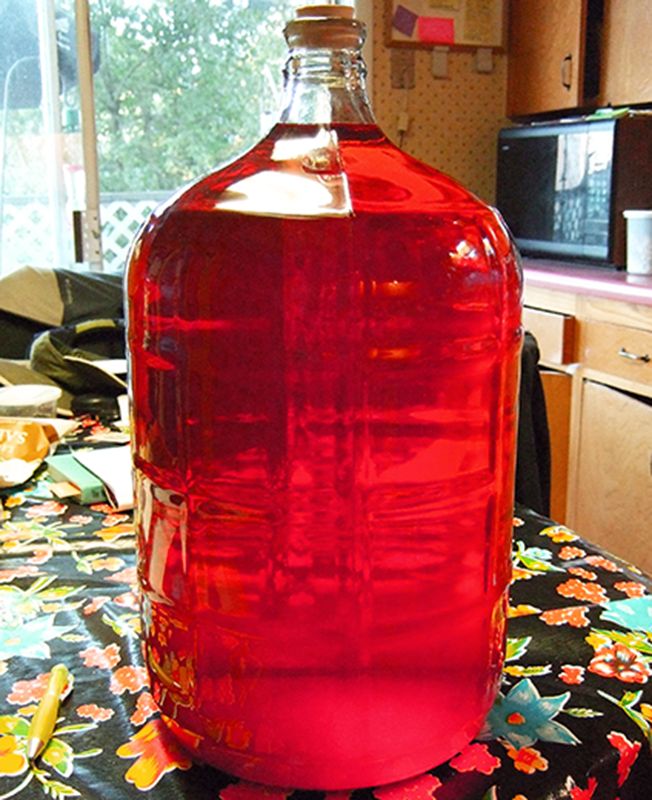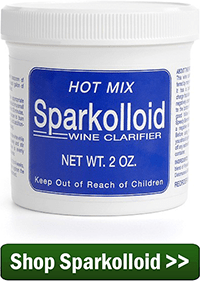 At what point do I add the Sparkolloid to my wine?
At what point do I add the Sparkolloid to my wine?
Jerre M. — TN
—–
Hello Jerre,
Thank you for the great question about when to add Sparkolloid to a wine.
Technically, Sparkolloid fining can be added anytime after the wine has stopped fermenting. However, normally it is added after the wine has been treated with bentonite fining. Sparkolloid powder is kind of the left-hook to the bentonite’s right-jab. One works to take out what the other can’t. You will find all the instructions for its use on the side of the container we offer.
Bentonite takes the most particulate out of the wine, so it is typically used first. Once the fermentation stops, a winery will add a dose of bentonite to drop out the the bulk of the proteins. This is mostly made up of yeast cells and tannin. Most would drop out on its own, but the bentonite helps it drop out more quickly.
While bentonite is the best at dropping out large amounts, what it is not particularly the best at is adding a polish to the wine, or getting out that final, last bit of particles. While the wine will look somewhat clear after a bentonite treatment, there are fining agents that can add more polish to the wine. This is where Sparkolloid finings come in. Sparkolloid powder is able to take out finer particles by neutralizing their electrical charge and allowing them to collect and drop out. This increases the luster or brilliance of the wine. For this reason, after a bentonite treatment is when to add Sparkolloid finings to a wine.
particles by neutralizing their electrical charge and allowing them to collect and drop out. This increases the luster or brilliance of the wine. For this reason, after a bentonite treatment is when to add Sparkolloid finings to a wine.
Sparkolloid powder is not good at taking out large volumes of particulate matter. For this reason, if you are only using Sparkolloid to fine your wine, then I would wait a month or two after the fermentation, to make sure that what can drop out on its own does so. Once the wine quits improving in clarity on its own, rack it off the sediment and add the Sparkolloid finings.
So, when to add Sparkolloid powder to a wine really depends on whether or not bentonite is being used beforehand. If so, wait about a week and then add it. If you are not using bentonite, then you may need to wait several weeks before the wine has cleared enough for Sparkolloid to be effective.
Happy Winemaking.

Hi, Is it necessary using two fining agents when fining red wine? There are also two agents in kits.
I tried just using one and it seems to be clear.
Rene, if the kit came with 2 packets of fining agents, i would recommend using them both. The purpose of the second packet is probably to add extra polish to the wine.
What about apple juice? It always clears on its own, but I want my cider to sparkle. I’m also looking to get it clear as quickly as possible.
Thanks
Darren
If you want sparkling cider, rack the completely fermented juice into a container and then mix in a little bit of fresh, non-fermented apple juice. Bottle it immediately from there. It is similar to how you would prime beer at home to be carbonated.
A hydrometer takes the guess work out. You don’t want to add more than a half of a percent of potential alcohol or you risk pushing the cork out or bottle explosion.
The juice will ferment some again inside the bottle giving you the sparkle. There will be a little sediment in the bottle that will settle but you can either just pour it like a craft beer or drink it mixed in. It doesn’t hurt the flavour at all.
Be sure not to add too much fresh juice. It doesn’t take much to get the job done.
Is sparkolloid powder best used after filtering or in replace of filtering, please and thanks?t
Terry, I would recommend using the sparkilloid prior to filtering the wine. Allow time for the sparkolloid to work before filtering.
If I use bentonite and sparkilloid do I need to rack the wine after using bentonite before using sparkilloid or just rack once after using both fining agents? What would be a reasonable time between treatments? Thanks.
Robert, there really is no reason to rack the wine in between the treatments. I would allow a few days after adding the bentonite for the particles to settle before adding the sparkolloid.
You say no need to rack the wine after I use bentonite before I add the sparkolloid. Do I need to stir the wine after I add sparkolloid?
Gary, the directions for the Sparkolloid do tell you to add the mixture very slowly and stir until the mixture is evenly blended throughout the wine.
Does adding the mixture decrease the alcohol content?
Calvin, using Sparkolloid will not lower the alcohol content of the wine.
We have racked Blackberry wine twice. The first racking was for a month to get the bulk of the sediment out. It’s in the second racking for about six weeks and still only translucent while blueberry wine is almost crystal clear after just a month. Should I rack the blackberry again then add the Sparkolloid or add it now to the second racking? How long should I let it sit after adding the Sparkolloid? Will I need to rack it once again after adding the Sparkolloid? So many questions, plenty of time.
Gordon, if there is sediment at the bottom, I would rack it before you add the Sparkolloid. The directions for Sparkolloid say to let the wine sit 2-4 weeks after adding or until the wine is clear. After it clears you will need to rack it again.
I do not use any fining agents in my dry red wine. No need to. Age them in cellar temps for one year being diligent in your racking schedule and the wine is super clear. Why add stuff when you do not need to. I have never had hazing issues.
I have made wine many times, and I usually wait four to six months before they clear totally, (time is best clarifier) and many times do not use fining agents. I have 6 gallons of Apple wine and 6 gallons of beet wine, currently aged 6 months. They have a very prominent haze. I used bentonite, as I have just a few times in the past with great success, however there seems to be no change after using bentonite. What do you think the issue is with these two batches. Will sparkolloid work, you think?
I agree, time can be a great clarifier.
Bentonite works off a static-cling effect. The bentonite has a static charge. So does Sparkolloid, but it has the opposite charge, so in theory, whatever one misses the other should get. So it should solve your problem.
However, this could also be a pectin haze you are dealing with. This is not a particle cloudiness that can be dragged out, but a visual change in the actual wine, itself. Here is more info on this:
Your Wine Could Be Cloudy Because Of A Pectin Haze
https://blog.eckraus.com/cloudy-pectin-haze-enzyme
At this point I would treat the wine with Sparkolloid. If that fails to give results, then you should assume you have a pectin haze issue and proceed accordingly from there.
Thank you, I had sparklloid ordered when I originally asked this question. It’s been one and a half days since I have added the sparklloid. The apple wine is clearing very well as particles are congealing and slowly falling to the bottom. I’m vibrating the carboy to assist in the clearing effort. Beet wine generally has a deep color and never looks totally polished. But I am assuming this should do the trick. If there was a pectin haze, I really wouldn’t worry too much about it, I would just be unsatisfied with the finished look. I was worried in the beginning I didn’t use the pectic enzyme in a correct amount. But all is looking well. Thank you so much for your advice. First time I have used sparklloid and I am feeling very impressed with the result.
I used Sparkolloid for the first time today and the instructions weren’t very clear. I added the powder to boiling hot water in a measuring cup and waited 5 minutes before adding it to my wine. Now I’m reading other posts that say it need to be actively boiling for the entire duration. Have I wrecked my wine?
Shawna, I doubt that you have harmed your wine in any way. However it may not effectively clear your wine. Below are the directions provided with our Sparkolloid.
1. For every gallon of wine to be clarified use one level teaspoon of Hot Mix Sparkolloid and 3 ounces of water.
2. In a pan bring the appropriate amount of water and Sparkolloid to a simmer for 30 minutes. Stir often. Do not allow the mixture to burn. Add more water if necessary.
3. Add the mixture to the wine while it is still hot. Add very slowly and stir until the mixture is evenly blended throughout the wine.
4. Let the wine set for 2 to 4 weeks, or until it has cleared. Siphon the wine off of the sediment.
I used sparkolloid before bentonite and am still allowing sparkolloid to settle, am I able to use bentonite after this or should I try dual fine or is my batch wrecked? 6 gallons is what I’m making. Followed instructions just got these 2 parts backwards.
My daughter has a shellfish allergy. Which fining is safe for her – bentonite or Sparkolloid?
Hi! There,
If I use only sparkolloid, that is good for wine, or do I need to use both?